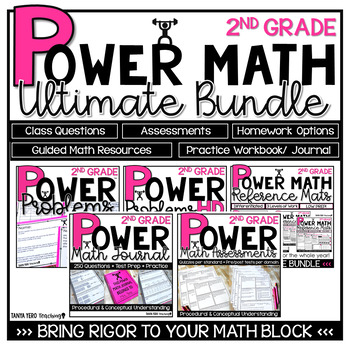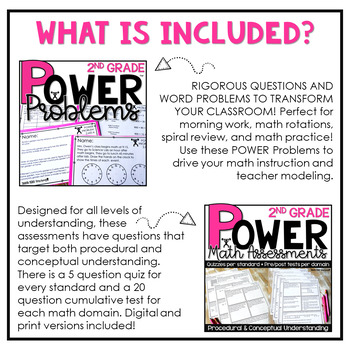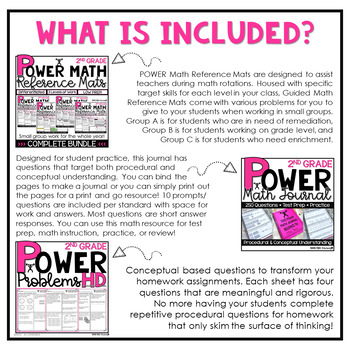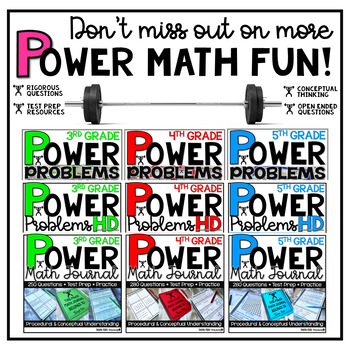2nd Grade Math Questions YEARLONG BUNDLE Assessments, Printables, and More!
- Zip
What educators are saying
Products in this Bundle (14)
showing 1-5 of 14 products
Description
The POWER Math Ultimate Bundle is everything you need for a successful year of math instruction! The resources found in this bundle were designed with the philosophy in mind that math should be POWERful. POWER stands for purposeful opportunities with engagement and rigor. You and your students deserve questions, assessments, printables and MORE that include questions that focus on conceptual learning.
SAVE $20 AND BUY THE BUNDLE!
What is included:
➥ POWER Problems- RIGOROUS QUESTIONS AND WORD PROBLEMS TO TRANSFORM YOUR CLASSROOM! Perfect for morning work, math rotations, spiral review, and math practice! Use these POWER Problems to drive your math instruction and teacher modeling.
➥ POWER Math Assessments- Designed for all levels of understanding, these assessments have questions that target both procedural and conceptual understanding. There is a 5 question quiz for every standard and a 20 question cumulative test for each math domain. Digital and print versions included!
➥ POWER Math Reference Mats- POWER Math Reference Mats are designed to assist teachers during math rotations. Housed with specific target skills for each level in your class, Guided Math Reference Mats come with various problems for you to give to your students when working in small groups. Group A is for students who are in need of remediation, Group B is for students working on grade level, and Group C is for students who need enrichment.
➥ POWER Math Journal- Designed for student practice, this journal has questions that target both procedural and conceptual understanding. You can bind the pages to make a journal or you can simply print out the pages for a print and go resource! 10 prompts/ questions are included per standard with space for work and answers. Most questions are short answer responses. You can use this math resource for test prep, math instruction, practice, or review!
➥ POWER Problems HD- Conceptual based questions to transform your homework assignments. Each sheet has four questions that are meaningful and rigorous. No more having your students complete repetitive procedural questions for homework that only skim the surface of thinking!
Topics Covered
Algebraic Thinking:
➥ 2.OA.1 - Represent and solve addition and subtraction word problems, within 100
➥ 2.OA.2 - Demonstrate fluency with addition and subtraction, within 20, using mental strategies
➥ 2.OA.3 - Determine whether a group of objects, within 20, has an odd or even number of members
➥ 2.OA.4 - Use addition to find the total number of objects arranged in rectangular arrays with up to 5 rows and up to 5 columns; write an equation to express the total as a sum of equal addends.
Geometry:
➥ 2.G.1 - Recognize and draw polygons
➥ 2.G.2 - Partition a rectangle into rows and columns
➥ 2.G.3 - Partition circles and rectangles into two, three, or four equal shares.
Numbers and Operations in Base Ten:
➥ 2.NBT.1 - Understand that the three digits of a three-digit number represent amounts of hundreds, tens, and ones.
➥ 2.NBT.2 - Count within 1,000; skip-count by 5s, 10s, and 100s.
➥ 2.NBT.3 - Read and write numbers, within 1,000, using base-ten numerals, number names, and expanded form.
➥ 2.NBT.4 - Compare two three-digit numbers based on the value of the hundreds, tens, and ones digits.
➥ 2.NBT.5 - Demonstrate fluency with addition and subtraction, within 100.
➥ 2.NBT.6 - Add up to three two-digit numbers using strategies based on place value and properties of operations.
➥ 2.NBT.7 - Add and subtract, within 1,000, relating the strategy to a written method.
➥ 2.NBT.8 - Mentally add 10 or 100 to a given number 100–900, and mentally subtract 10 or 100 from a given number 100–900.
Measurement and Data Topics Covered
➥ 2.MD.1 - Measure the length of an object in standard units
➥ 2.MD.2 - Measure the length of an object twice, using length units of different lengths for the two measurements
➥ 2.MD.3 - Estimate lengths in using standard units of inches, feet, yards, centimeters, and meters
➥ 2.MD.4 - Measure to determine how much longer one object is than another, expressing the length difference in terms of a standard length unit
➥ 2.MD.5 - Use addition and subtraction, within 100, to solve word problems involving lengths that are given in the same units
➥ 2.MD.6 - Represent whole numbers as lengths from 0 on a number line diagram
➥ 2.MD.7 - Tell and write time from analog and digital clocks to the nearest five minutes, using a.m. and p.m.
➥ 2.MD.8 - Word problems with money
➥ 2.MD.9 - Interpreting data on a line plot
➥ 2.MD.10 - Organize, represent, and interpret data with up to four categories.





